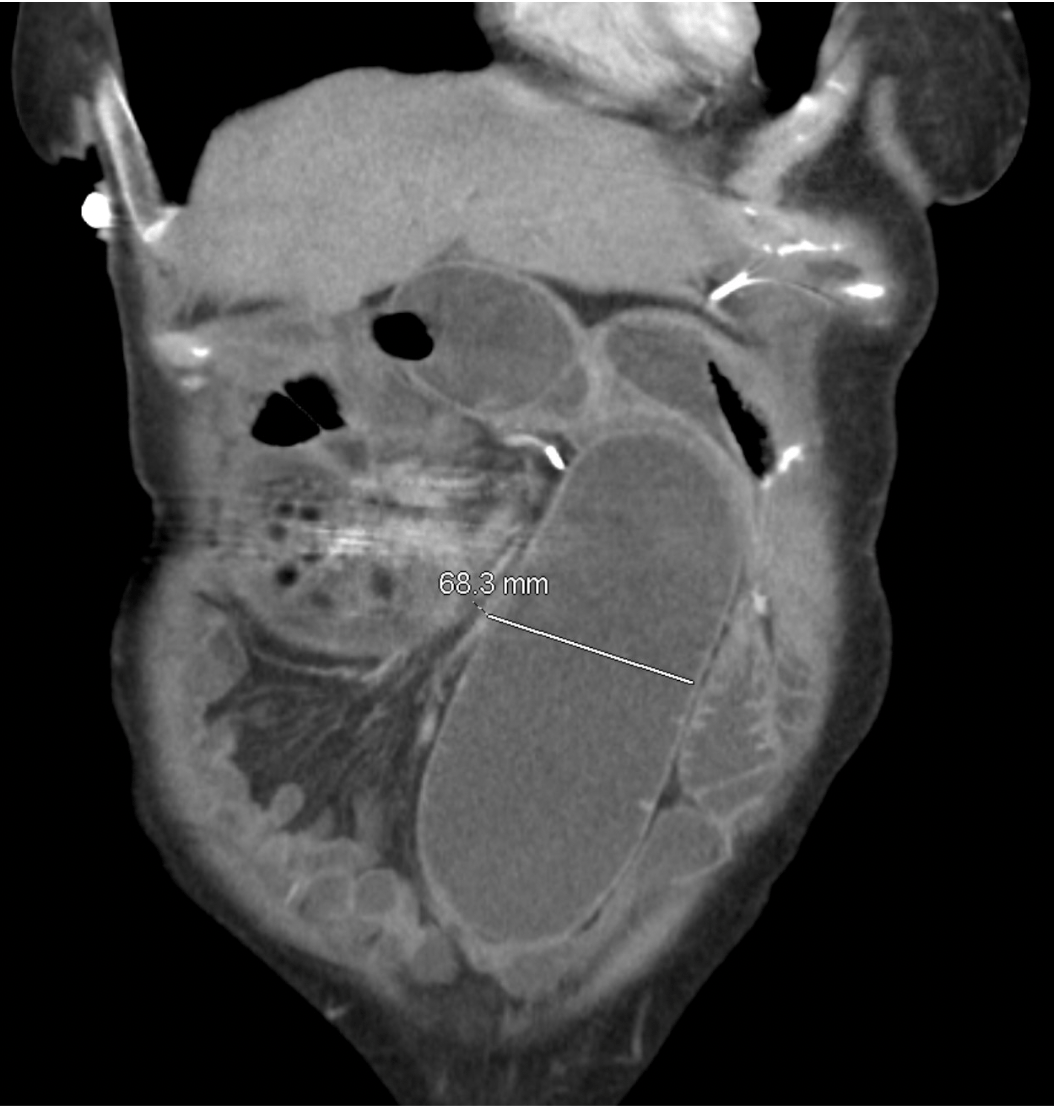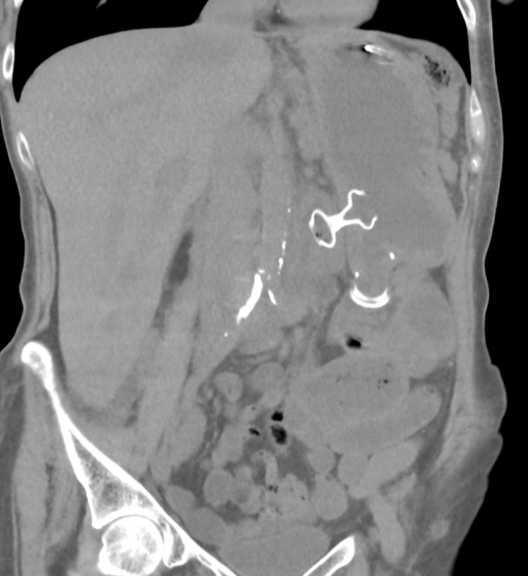Sunday Poster Session
Category: Interventional Endoscopy
P1480 - Advanced Endoscopic Management of Benign Afferent Limb Syndrome and Gastrojejunostomy Strictures: A Case Study
Sunday, October 26, 2025
3:30 PM - 7:00 PM PDT
Location: Exhibit Hall
- HS
Henry Shay, MD
University of Louisville
Louisville, KY
Presenting Author(s)
Nosheen Hafeez, MD1, Henry Shay, MD2, FNU Murlidhar, MBBS, MD3, Nanlong Liu, MD2
1Baptist Health-University of Arkansas for Medical Sciences, North Little Rock, AR; 2University of Louisville, Louisville, KY; 3Mayo Clinic, Rochester, MN
Introduction: Afferent Limb Syndrome (ALS ) is a complication after gastrectomy with gastrojejunostomy, occurring in 0.2%-1% of the cases. ALS involved obstruction of the afferent limb leading to abdominal complications. While lumen-apposing metal stents(LAMS) are mainly studied in malignant ALS, evidence suggests they're effective for benign strictures showing high success. We highlight a similar case.
Case Description/
Methods: A 52-year-old female with a history of gastroparesis, autoimmune dysmotility and peptic ulcer disease complicated by gastric and recurrent duodenal ulcers with duodenal stricture status post-gastrojejunostomy presented with nausea and vomiting. Previously a push enteroscopy was performed for endoscopic decompression of the afferent limb. A subsequent EGD revealed a dilated stomach with an unidentifiable afferent limb and Grade D esophagitis. On readmission, she was found to have cholestatic liver injury and an elevated lipase of 1500. CT imaging showed evidence of a dilated afferent limb with intra- and extrahepatic biliary dilation and pancreatic inflammation. Her presentation was consistent with afferent limb syndrome, likely exacerbated by a concurrent efferent limb stricture, leading to gastric distension and obstruction. After multidisciplinary discussion, EUS-guided drainage with lumen-apposing self-expanding metal stent (LA-SEMS) stent placement was elected. During the procedure, a 15mm circumferential stricture at the GJ anastomosis was identified, likely contributing to obstruction of the afferent limb and pancreaticobiliary drainage. A separate short-segment stricture was also identified in the efferent limb, further complicating gastric emptying. A 20mm LA-SEMS(AXIOS) stent was placed in the afferent limb, immediately releasing 2 liters of bilious fluid, confirming decompression. A second 20mmx10mm AXIOS stent was placed across the GJ anastomosis to address the efferent limb stricture and improve gastric emptying. Post-procedure, the patient reported significant improvement in her symptoms and was discharged the next day.
Discussion: ALS post-gastrojejunostomy remains rare but clinically significant. We report successful treatment of benign ALS using dual EUS-guided 20mm LAMS, achieving prompt decompression and symptom resolution. EUS-GJ represents a minimally invasive alternative to surgery or PTBD, with emerging data supporting its role in benign disease. This identifies the need for prospective studies to optimize stent management and define long-term outcomes.

Figure: Dilated duodenum and proximal jejunum with a maximum diameter of about 6.8 cm up to the transition point at the left lower quadrant adjacent to gastrojejunostomy. This is mildly increased compared to prior.

Figure: Post-AXIOS placement CT in the coronal view shows decompression of the previously dilated afferent limb, with the stent in place, and resolution of the upstream duodenal and jejunal dilation, which previously measured up to 6.8 cm.
Disclosures:
Nosheen Hafeez indicated no relevant financial relationships.
Henry Shay indicated no relevant financial relationships.
FNU Murlidhar indicated no relevant financial relationships.
Nanlong Liu indicated no relevant financial relationships.
Nosheen Hafeez, MD1, Henry Shay, MD2, FNU Murlidhar, MBBS, MD3, Nanlong Liu, MD2. P1480 - Advanced Endoscopic Management of Benign Afferent Limb Syndrome and Gastrojejunostomy Strictures: A Case Study, ACG 2025 Annual Scientific Meeting Abstracts. Phoenix, AZ: American College of Gastroenterology.
1Baptist Health-University of Arkansas for Medical Sciences, North Little Rock, AR; 2University of Louisville, Louisville, KY; 3Mayo Clinic, Rochester, MN
Introduction: Afferent Limb Syndrome (ALS ) is a complication after gastrectomy with gastrojejunostomy, occurring in 0.2%-1% of the cases. ALS involved obstruction of the afferent limb leading to abdominal complications. While lumen-apposing metal stents(LAMS) are mainly studied in malignant ALS, evidence suggests they're effective for benign strictures showing high success. We highlight a similar case.
Case Description/
Methods: A 52-year-old female with a history of gastroparesis, autoimmune dysmotility and peptic ulcer disease complicated by gastric and recurrent duodenal ulcers with duodenal stricture status post-gastrojejunostomy presented with nausea and vomiting. Previously a push enteroscopy was performed for endoscopic decompression of the afferent limb. A subsequent EGD revealed a dilated stomach with an unidentifiable afferent limb and Grade D esophagitis. On readmission, she was found to have cholestatic liver injury and an elevated lipase of 1500. CT imaging showed evidence of a dilated afferent limb with intra- and extrahepatic biliary dilation and pancreatic inflammation. Her presentation was consistent with afferent limb syndrome, likely exacerbated by a concurrent efferent limb stricture, leading to gastric distension and obstruction. After multidisciplinary discussion, EUS-guided drainage with lumen-apposing self-expanding metal stent (LA-SEMS) stent placement was elected. During the procedure, a 15mm circumferential stricture at the GJ anastomosis was identified, likely contributing to obstruction of the afferent limb and pancreaticobiliary drainage. A separate short-segment stricture was also identified in the efferent limb, further complicating gastric emptying. A 20mm LA-SEMS(AXIOS) stent was placed in the afferent limb, immediately releasing 2 liters of bilious fluid, confirming decompression. A second 20mmx10mm AXIOS stent was placed across the GJ anastomosis to address the efferent limb stricture and improve gastric emptying. Post-procedure, the patient reported significant improvement in her symptoms and was discharged the next day.
Discussion: ALS post-gastrojejunostomy remains rare but clinically significant. We report successful treatment of benign ALS using dual EUS-guided 20mm LAMS, achieving prompt decompression and symptom resolution. EUS-GJ represents a minimally invasive alternative to surgery or PTBD, with emerging data supporting its role in benign disease. This identifies the need for prospective studies to optimize stent management and define long-term outcomes.

Figure: Dilated duodenum and proximal jejunum with a maximum diameter of about 6.8 cm up to the transition point at the left lower quadrant adjacent to gastrojejunostomy. This is mildly increased compared to prior.

Figure: Post-AXIOS placement CT in the coronal view shows decompression of the previously dilated afferent limb, with the stent in place, and resolution of the upstream duodenal and jejunal dilation, which previously measured up to 6.8 cm.
Disclosures:
Nosheen Hafeez indicated no relevant financial relationships.
Henry Shay indicated no relevant financial relationships.
FNU Murlidhar indicated no relevant financial relationships.
Nanlong Liu indicated no relevant financial relationships.
Nosheen Hafeez, MD1, Henry Shay, MD2, FNU Murlidhar, MBBS, MD3, Nanlong Liu, MD2. P1480 - Advanced Endoscopic Management of Benign Afferent Limb Syndrome and Gastrojejunostomy Strictures: A Case Study, ACG 2025 Annual Scientific Meeting Abstracts. Phoenix, AZ: American College of Gastroenterology.
